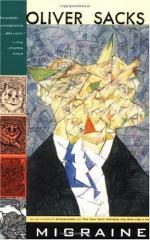
|
| Name: _________________________ | Period: ___________________ |
This test consists of 5 multiple choice questions, 5 short answer questions, and 10 short essay questions.
Multiple Choice Questions
1. Changes in the sensory __________ are another possible part of the aural symptoms, according to Sacks.
(a) Experiences.
(b) Movements.
(c) Manner.
(d) Threshold.
2. The ________ who was restricted from normal social activities might be suffering from migraines as a result of depression.
(a) Student.
(b) Nun.
(c) Priest.
(d) Monk.
3. Sacks points out that there is a tendency to _________ migraine sufferers in literature and in descriptions.
(a) Ignore.
(b) Criticize.
(c) Romanticize.
(d) Avoid.
4. There are some patients that obviously suffer from periodical or causal attacks but that the larger group will defy easy _____________.
(a) Study.
(b) Peace.
(c) Treatment.
(d) Classification.
5. __________ migraines are always present in those who have cases of severe nausea along with their pain.
(a) Blue.
(b) Red.
(c) Green.
(d) White.
Short Answer Questions
1. What is caused by the arterial pulses and pressure on the affected artery can help during a migraine?
2. Sacks pointed out that a woman's hair turned __________ on one side, the side where she would have her headaches.
3. There are other hallucinations in which _________ may appear to be bigger or smaller than they actually are.
4. One patient believes there are small _________ in the room with him, even when there are not.
5. What tends to increase over the course of an experience of a migraine headache?
Short Essay Questions
1. What does Sacks have to say about the tendency of migraines to be a part of one's life throughout the years?
2. What did the fifty-three year old female patient say characterized the start of her migraines?
3. What are the five categories of aural symptoms, according to Sacks in this book?
4. What are the symptoms that the German physician has when he has his migraines?
5. What can often be a secondary factor to the migraine pain, according to the author of this book?
6. What does one researcher equate the migraine with, which might be helpful in treating them?
7. What are the causes of serious losses of fluids during the experience of a migraine, according to Sacks?
8. What are the classic symptoms of a migraine, according to Sacks' experience with his patients?
9. Why do many migraine sufferers tend to rub one side of their head when they are in the midst of a migraine?
10. How does Sacks propose the genetic link of migraines be tested in order to assure that environmental conditions are not the cause?
|
This section contains 628 words (approx. 3 pages at 300 words per page) |

|




